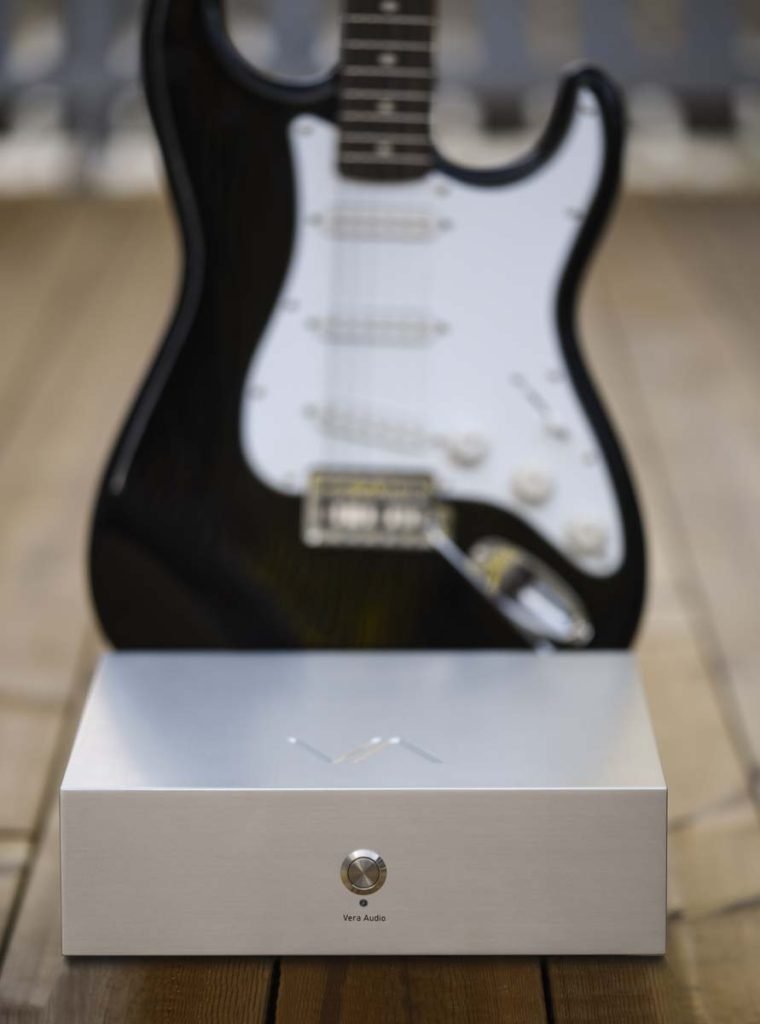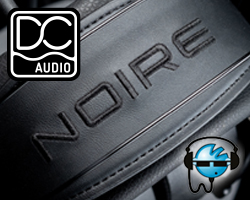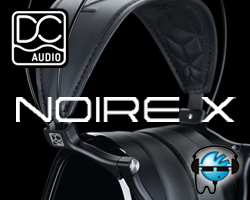VERA AUDIO POWER AMPLIFIER P400/1000 REVIEW
Vera Audio Power Amplifier P400/1000 is a Class D amplifier based around the Hypex NCore modules and coming in a bespoke case with some novel features such as a bespoke buffer stage and an interesting case design.
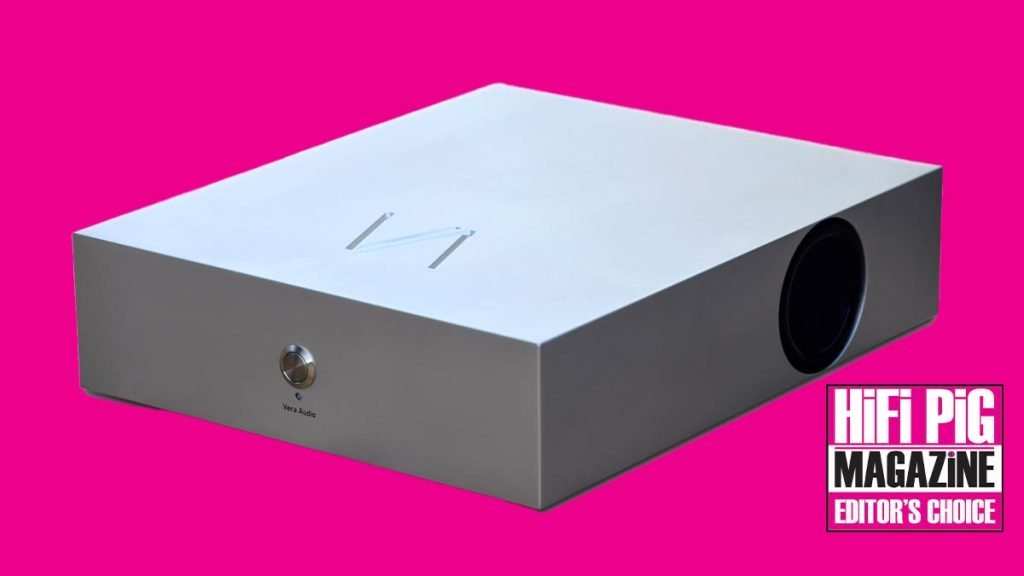
WHO ARE VERA AUDIO
Vera Audio is (currently) a small Norwegian manufacturer that has just three products (all power amplifiers) in their product range, but their website does make a claim (from Nov 2022) that they are working on developing a “world-class” horn loudspeaker, which given the specifications and aspirations outlined, looks to be a very interesting product indeed.
The company’s website tells us Vera is from the Latin root meaning true and they tell us that this is the goal of the brand. They also tell us that they are seeking to put forward an honest approach to the representation of their products and focus on a “non snake-oil” approach, whatever that is. Actually, I’m being a little facetious here and I do think that this strategy is a sensible one, if only to avoid the constant cries of social media commentators of “snake oil” for anything that doesn’t fit in with their own views on what audio should be and how it should be conceived. I digress.
Vera Audio continues to tell us in their spiel that they believe in an “objective approach where measurement and listening go hand in hand” and for me, this is a very sensible way to go as it allows for the discipline of a measured and proven scientific methodology, but still allows for them to bring in the human approach (listening) to the equation when voicing their products. They tell us that “A measurement alone is meaningless unless it is related to what we hear” and for me, this is exactly where many folk that scream measurement figures over listening ad-nauseam stumble. This balance of using the perceived audio (listening) along with measurements is an excellent way to create tools for listening to music in my opinion and serves everyone concerned better than either of the two extremes.
Vera Audio also tell us that they want to offer their products at a fair price, will not use hype, over-exaggerated message, or language that may mislead people, and will use honest language about what can be expected from their products.
Currently both their products are sold exclusively through a company called Lyd & Akustikk, a Norwegian retailer that sells a range of room treatment products and the two Vera Audio amplifiers.
The amplifier we have here is available in black or silver and costs 28,000 NOK plus VAT and presumably any import duties relevant to your location. The price equates as this article is being written to £2121 or 2437 euros plus VAT.
BUILD AND FEATURES OF THE VERA AUDIO P400/1000 POWER AMPLIFIER
Out of the box this unit looks to be exceptionally well crafted and put together. The silver finish is really rather lovely and the amp is pretty compact (29 x 8.2 x 38cm WHD) but also has a good weight to it at 9kg. There is a VA logo cut into the aluminium chassis on top but that’s pretty much all the adornment you get.
The name of the amp is pretty sensible once you realise that can be bridged and its quoted power out puts are given as 400W into 8 ohms (max 1% THD+N) or 300W into 8 ohms (max 0.004% THD+N), and 750W into 4 ohms (max 1% THD+N) or 550 into 4 ohms (max 0.004%THD+N). In bridged mode, you get 1500W into 8 ohm (max 1% THD+N) or 800W into 8 ohms (max 0.004% THD+N). These are pretty healthy figures and I can’t envisage many loudspeakers that the Vera Audio amp would struggle to drive. For those interested, Vera Audio provides a downloadable data sheet for their measurements.
For those that want to try Bi-Amping the manual gives the following information: “Bridge function can also be useful in a set up where bi-amping is used. While the left XLR input is deactivated, all four speaker terminals are still active running from the right XLR input. This can be used in several configurations. One example would be to connect the woofer system to the left speaker terminals and midrange/tweeter to the right speaker terminals. In this setup, the right and left outputs will have the same output power as in stereo mode”.
Around the back of the amplifier, you have a well-laid-out panel with a pair of selectable gain knobs (one for each channel) and which goes up in 3dB steps from 12db to 30dB (plus mute) in stereo mode. I quite liked this feature! There’s a switch to choose bridged or stereo modes, a 12V trigger (not something I’ve ever used), a pair of XLR inputs (no RCA), and some very nice quality speaker binding posts…oh, and the power inlet and master power switch.
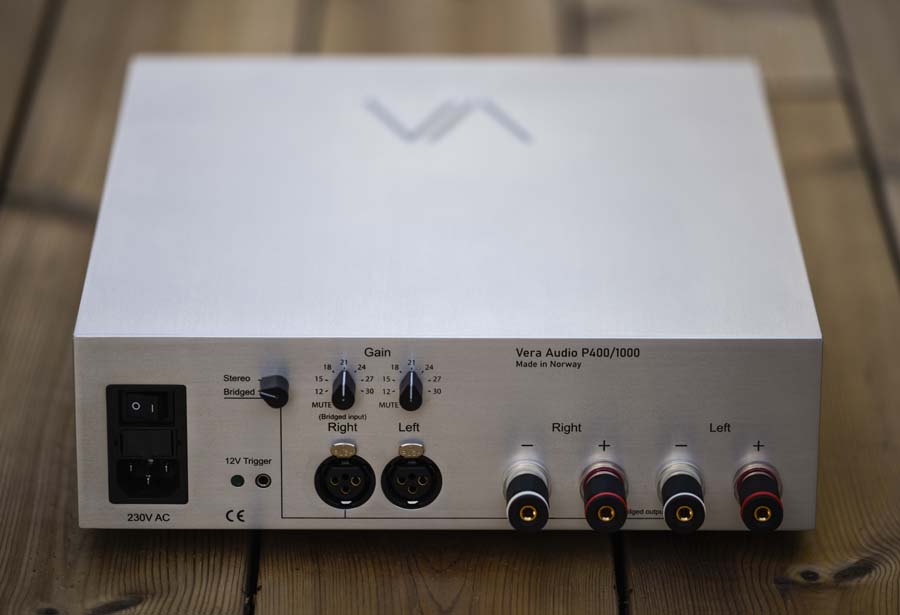
The front of the amplifier is Scandinavian simplicity and elegance personified and there is a simple button placed centrally that has an LED beneath it and beneath that the very tiny branding. Personally, I really like this simple and elegant approach.
When the amp is turned on at the back it goes into standby mode and the LED is purple for a few seconds before turning white and indicating that the amplifier is ready to play. If the input signal to the amp is too high then the amp’s protection circuits will be triggered and the LED will indicate this with a red/green light depending on which channel has been turned off. There are other functions of the LED to indicate error messages but I didn’t experience them and so are beyond the scope of this review. The LEDs are not of the type that could double as aircraft landing lights or lighthouse beacons and are very nice and low-key subtle.
The casework on the amplifier is very nice indeed and has vents for the internal fans – something I wasn’t expecting, but which should only come into operation when the amp is pushed very hard and continuously or it is placed in a room that is hotter than 30 degrees celsius. A cool (pun intended) of the amp is that these fans have “mesh” filters situated either side of the amp that trap any dust from getting into the amp when the fans are working and these (they are attached magnetically) can be removed and cleaned should you ever need to.
Clearly, there is a lot of thought gone into this amplifier and whilst it is based on Ncore NC500 modules, it would seem that this is not another Class D amp where the modules are simply whacked in a box with a suitable power supply. Indeed, the company’s website talks of there being no degrading potentiometers in the signal chain, a bespoke buffer stage, and “multi-step EMI filtering in the input stage to “keep harmful radio waves from the audio circuit”. In addition to this Vera Audio tell us that the “entire entrance stage is mounted in a screen in a separate chamber inside the cabinet” and the Neutrik XLR connectors are also given extra shielding.
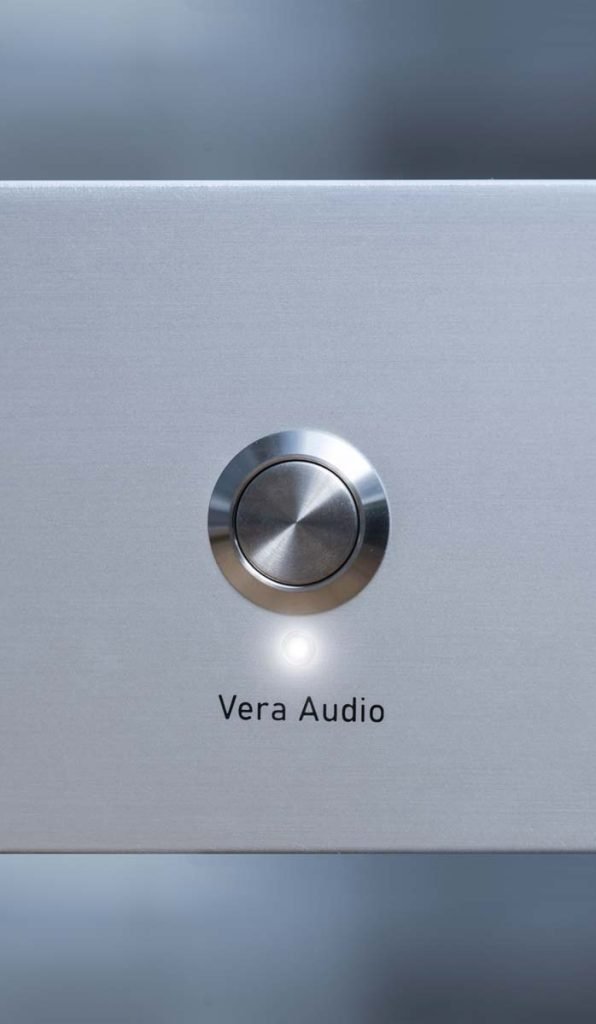
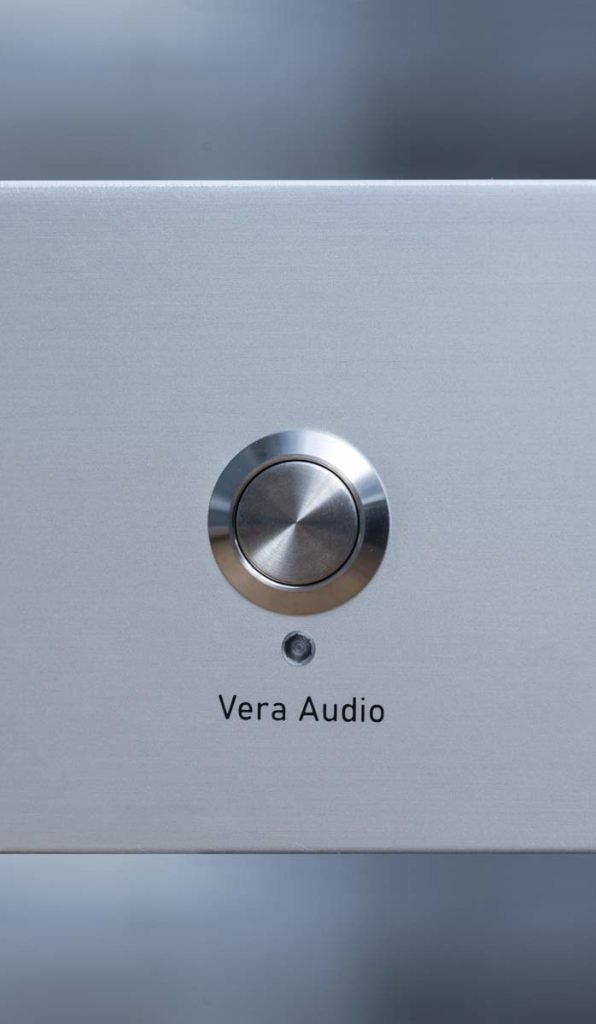
And that’s your lot with regards to how this amplifier is put together. From my perspective what I like about this amp is, as I mentioned, that it’s not just a couple of Ncore modules put in a box. There seems to have been a lot of thought and consideration given to the design of the amplifier and a level of transparency as to what has been done that is rare in the audio industry.
SOUND OF THE VERA AUDIO POWER AMPLIFIER
For the duration of this review, the amp was hooked up to our VINIUS Preamplifier, Audiovector R6 speakers, and the usual reference electronics and sources we use in all our tests.
I am no stranger to Class D amplifiers and certainly no stranger to the NCore modules used in this amp. I’ve been a long-time champion of Class D and I genuinely believe that they offer superb sound (when implemented well) for very little (in the grand scheme of things) outlay. For me the key features and benefits of Class D are that they are very quiet and very clean sounding. However, I must add that despite all that, in the main reference system, we have chosen to go with Class A and Class A/B amplifiers more recently, though in our second system, the Class D Merrill Thor amplifiers remain.
With regards to set up, I did experiment quite a bit with the gain switches to get what I considered to be the best match for our TVC amp and I found that the 21 dB position worked best in this set up. The gain feature is one that I think is a really excellent feature on this power amplifier as it allows its optimal use with any number of preamplifiers, with the caveat that they must have XLR outputs.
I never noticed the fans come switch in and so can’t comment on how quiet or otherwise they are.
Needless to say this is a deathly quiet amplifier and when I put on the start of Butthole Surfers’ Sweat Loaf I had to check to see that it was actually playing – it was. Continuing the Butthole Surfers’ theme I played the opening track of Peaches vs Gibby Haynes and His Problem (redneck Sex) mainly for the bass noise at the start of the track, but also because it’s a brilliant record. The amp doesn’t miss a beat and goes low and is fast and precise with this synthesised bass note that gradually becomes more distorted as the tune continues and the amp captures this excellently, as I assumed it would. What you have here is a kind of sterile amp and whilst some of you reading that statement are going to recoil in horror and immediately see that as a bad thing, the truth of the matter is that if you are looking for what many believe to be the holy grail of amplifier design – a straight wire with gain – then I would suggest this amplifier, and others of its ilk, are going to be right up your street as they add very little of their own flavour to the musical proceedings. Yes, I’m well aware that I’ve already said we no longer use Class D in this system, but if I was on a tighter budget then I’m pretty sure that Class D (and perhaps even this very amplifier) would find its way into the system and remain there – certainly, if I was looking at an amp in the sub £3K range then Class D amps would feature large.
The live recording of Poison Girls Voodoo Pappadollar off the Dig This record comes across as exactly what it is – a pretty basic live recording. However, that is what the recording sounds like and the powerful fragility of Vi’s vocal comes across brilliantly “live” and a bit crap. My copy of this is not a good one and the Vera Audio amplifier hides none of this, nor the background hum that is on this copy. This is a mixed bag, of course, and it means that unless you have good recordings of well-produced tracks, you are going to notice their shortcomings. Actually, I think this is a good thing and to some extent (and I’m going to contradict myself somewhat with regards to statements I’ve made before) this makes the case for spending on quality recordings, though I’d temper this with there being a limit to what I think are reasonable prices to ask for “audiophile” recordings.
Cut to the excellently recorded and self-titled album ti-an-guis (96/24) and you are presented with what I guess is on the file and the original recording. There are fast-paced dynamics on show and the sweetness of the vocal performance shines through, as do the acoustics of the recording and the recording space, but that is sort of what was to be expected.
Distortion is, to my lugs, inaudible and any colouration and “flavour” is coming from the DAC and the speakers we use in this system.
There’s really not much else to say about this amplifier if I’m honest, and whilst it would be easy for me to ramble on about this record I listened to and go into the fine detail of everything I heard in a particular recording, I genuinely don’t think there is a great deal of point in doing that here. What we have here is an amplifier that, to my ears, is pretty much as true to what it is being fed as you can get – this is true of many Class D amps. I don’t think it has the bass slam of our Electrocompaniet amplifier, and I don’t think the sound staging is as impressively three-dimensional, but the question then needs to be asked “are these on the file or constructs of the amplifier and speaker interaction”…or put more simply, “which is the more true representation of the file?” I don’t know the answer to that particular question, of course.
This latter point is a much wider discussion in audio and we start to bring in personal preference and taste into the equation. Personally, I’d much rather have our Electrocompaniet in this system as it suits me, my tastes, and the music I play, whilst remaining pretty (but not absolutely) neutral and “straight wire with gain” in its playing. However, if I were to be looking for a tool that gave truth (a tool for measurement, perhaps) then maybe I should be looking at the Vera Audio amplifier. However (and there are a lot of “howevers” in this review), I don’t only use this system to review kit, I use it for my own personal pleasure, and for that reason the much more expensive Electrocompaniet will be staying! This is not to say that the Vera Audio amplifier is not a pleasure to listen to, it is, what I am getting at is that in audio we are looking to get much more from our chosen kit than that “straight wire with gain”, though I’m sure there will be those reading this and screaming at their screens and saying “no, that is exactly what we are looking for!”. I maintain that the sooner we start to appreciate that audio and the pursuit of audio-nirvana is not a simple case of producing the most transparent this or that, then the better we will understand individuals’ choices in the kit they have in their systems.
With all that said, this could well be the best sub 3000 euro Class D amp I have used in this system…though I can’t actually accurately remember each and every amplifier that has gone through this system. I do think it is a better amplifier than the Thor Merrill amps we use and that is perhaps a better comparison both in price and in their make-up than the Electrocompaniet which is ten times its price. Put it this way, if I had to get rid of the current Electrocompaniet amplifier and rationalise my spending, then this would be very high on my list of amplifiers that I’d be looking at, but I’d probably want to add a little softening and put before it a valve amplifier rather than the massively transparent Vinius TVC we currently use and I’d probably buy two. I believe that it is hugely transparent and truthful to the signal it is being fed, whilst not feeling massively clinical or etched in the upper frequencies as I have heard in some amplifiers that push the tops to allude to clarity but which can soon become rather tiring to listen to.
The award I am giving this amplifier is based on comparing it to the Class D amplifiers we own and use as a reference. In this system the Vera Audio amplifier performed at a better level than our Merrill Thor Class D amplifiers, whilst costing significantly less. In general, I believe that Class D amplifiers based on the Hypex modules perform above their pricepoint when compared to Class A and A/B amplifiers and as such there are many that offer excellent value. Given their modular nature, performance is not likely to fall below a given level, but some are better than others and I believe this is down to the buffer stages used and the power supplies – the Vera Audio amp we had in for review scores very highly in these respects, but it also has innovative touches such as the variable gain controls to aid with preamplfier/speaker matching, the onboard fans, and the excellent casework and speaker terminals. This is an excellent iteration of Class D tech’ and I highly recommend it, with some of the caveats outlined throughout this review.
CONCLUSION
I actually think that this is a bit of a steal of an amplifier for the asking price and I think that at this price it is the best Class D amplifier I have yet heard (caveat – from memory) – I have not heard the Mola Mola offerings in our system and so cannot comment on them and where this amp sits.
Class D is an interesting beast and the argument may well be that one Ncore NC500 should sound pretty much the same as all the others, but this is just not my experience and some are definitely better than others and I think a good deal of that is down to the buffer-stage and power supplies used.
The attention to detail with the Vera Audio amp is really excellent and whilst some may well moan that this is a module amp and so costs are known, the truth is that there are little details here that stand this amp apart from the crowd; The excellently thought out bodywork, the gain switches, the LED on the front ( I haven’t gone into the whole way it works for errors), the very good quality speaker cables…
In this system, the amp was deadly quiet to the point I had to check at least one record was playing and as such it should be an excellent match for ultra-sensitive loudspeakers (though the power it has is going to be overkill) like single-driver widebanders or horns.
I thoroughly recommend this amplifier from a brand I had not heard of before but wish all the very best for the future.
AT A GLANCE
Build And Features:
A nice looking and well-put-together package with good quality hardware like the speaker binding posts
The magnetic fan filters are a nice touch as is the logo on the top of the unit
Clever but not obtrusive LED on the front
Onboard fans to keep it cool but I never had them used
The 12V trigger was superfluous to my needs
Sound Quality:
Like most high-quality Class D amplifiers that I have heard, this amp is quiet and very transparent sounding, to the point that some may well wish to temper that with something a little smoother sounding by way of a preamplifier
Clinical sounding but not artificially so in the top-end presentation
Good bass slam but I prefer a little more lift in this region
The soundstaging is good and likely accurate but perhaps I prefer a little more boost here too
Value For Money:
The Vera Audio amplifier is a very nicely put-together bit of kit that sounds excellent. Personally, I think it offers very good value for money, despite it costing more than some of the other boutique makers of Hypex module amplifiers
We Loved:
Its transparency and relative truthfulness to the files that it is presented with
The fit and finish are great
It really is VERY quiet with no background hum or any noise
We Didn’t Love So Much:
Can be a little too much with high-resolution recordings and some will want to temper that with a less revealing or more soft-sounding preamplifier. I have made this comment about several Class D amplifiers in the past
Crap records still sound crap and the amp isn’t going to mask poor recordings or bad copies of records – this is what you accept with high-fidelity reproduction
You will need good quality components ahead of this amplifier otherwise it will pretty quickly reveal their inadequacies
Elevator Pitch Review: This Norwegian amplifier is beautifully and thoughtfully constructed around the Hypex NC500 modules with a buffer stage made by Vera Audio. Sonically it is much of what you would expect from a well-put-together Class D amplifier and majors on quietness allied with an unembellished sonic performance.
Price:
28,000 NOK, which at the time of writing equates to £2121 or 2437 euros plus VAT.
SUPPLIED SPECIFICATIONS
– Selectable gain in very accurate 3dB steps from 12dB to 30dB as well as mute function
– CMRR of at least 89dB@100Hz and better than 89dB@1kHz (measured based on the IEC 60268-3 standard)
– Very low noise of less than 15uV
– S/N of more than 130dB (stereo)
– S/N of more than 132dB (bridged)
Technical data is measured with 240V current on 10 random units. Minimum values are stated.
Output impedance (20-20kHz) < 5mΩ
Input impedance 47kΩ
Noise () < 15uV
Frequency response DC-20kHz = +0 to -0.5dB
Signal-to-Noise Ratio stereo > 130dB
Signal-to-Noise Ratio bridged >132dB
Damping factor > 1600 with 8Ω speakers
Standby power 0.25W















































